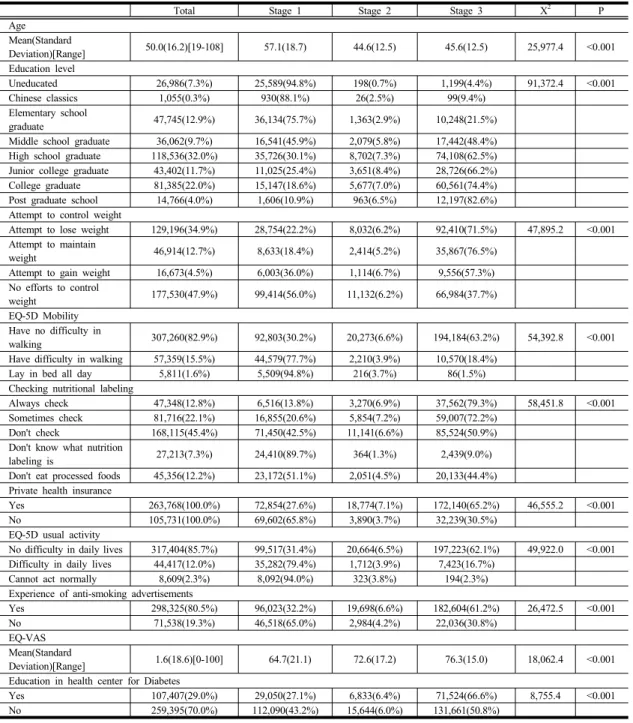Vol. 18, No. 12 pp. 581-588, 2017
Factors influencing metabolic syndrome perception and exercising behaviors in Korean adults: Data mining approach
Soo-Kyoung Lee
1, Mikyung Moon
2*1
College of Nursing, The Research Institute of Nursing Science, Keimyung University
2
College of Nursing, The Research Institute of Nursing Science, Kyungpook National University
대사증후군의 인지와 신체활동 실천에 영향을 미치는 요인 : 데이터 마이닝 접근
이수경1, 문미경2*
1
계명대학교 간호대학, 간호과학연구소
2
경북대학교 간호대학, 간호과학연구소
Abstract This study was conducted to determine which factors would predict metabolic syndrome (MetS) perception and exercise by applying a machine learning classifier, or Extreme Gradient Boosting algorithm (XGBoost) from July 2014 to December 2015. Data were obtained from the Korean Community Health Survey (KCHS), representing different community-dwelling Korean adults 19 years and older, from 2009 to 2013. The dataset includes 370,430 adults. Outcomes were categorized as follows based on the perception of MetS and physical activity (PA): Stage 1 (no perception, no PA), Stage 2 (perception, no PA), and Stage 3 (perception, PA). Features common to all questionnaires for the last 5 years were selected for modeling. Overall, there were 161 features, categorical except for age and the visual analogue scale (EQ-VAS). We used the Extreme Boosting algorithm in R programming for a model to predict factors and achieved prediction accuracy in 0.735 submissions. The top 10 predictive factors in Stage 3 were: age, education level, attempt to control weight, EQ mobility, nutrition label checks, private health insurance, EQ-5D usual activities, anti-smoking advertising, EQ-VAS, education in health centers for diabetes, and dental care. In conclusion, the results showed that XGBoost can be used to identify factors influencing disease prevention and management using healthcare bigdata.
요 약 본 연구는 기계 학습법 중 하나인 XGBoost를 이용하여 대사증후군을 인지하고 신체활동을 수행하는 집단을 예측하 고자 2014년 7월부터 2015년 12월까지 시도되었다. 이에 2009-2013년 지역사회건강조사를 연구자료로 사용하였고 370,430 명의 성인을 분석에 포함하였다. 본 연구의 종속변수는 대사증후군의 인지 및 신체활동 실천정도에 따른 단계로 3단계로 구분하였다:Stage 1(무인지, 무 신체활동), Stage 2(인지, 무 신체활동), and Stage 3(인지, 신체활동). 예측변수로는 5년간의 지역사회건강조사 중 공통으로 수집된 문항으로부터 161개의 특성을 선택하였다. 자료 분석을 위해 R program을 이용하여 XGBoost 알고리즘을 적용하였다. 분석 결과 정확도는 0.735 이었으며, 가장 영향을 미치는 10개의 특성은 나이, 교육수준, 체중조절시도 경험, EQ-5D 운동능력, 영양표시 확인, 개인 건강보험가입 유무, EQ-5D 일상활동, 금연광고경험 여부, 통증 유무, 당뇨에 대한 보건기관의 교육 경험 순으로 확인되었다. 본 연구결과는 XGBoost가 보건의료빅데이터를 이용한 질병의 예방과 관리에 영향을 주는 요인을 확인하는데 유용한 도구임을 보여주었다. 또한, 본 연구를 통해 대사증후군에 취약한 계층 을 확인하고 이를 위한 교육프로그램 개발에 도움을 줄 수 있을 것으로 보인다.
Keywords : Healthcare Bigdata, Korean Community Health Survey, Machine Learning, Metabolic Syndrome, XGBoost
This work was supported by the Bisa Research Grant of Keimyung University in 2014.
*

